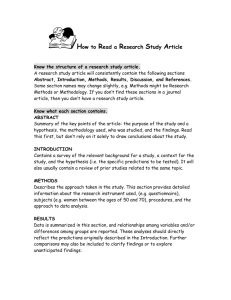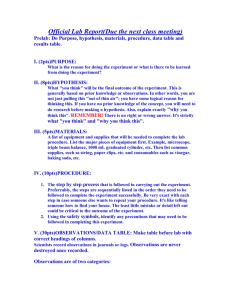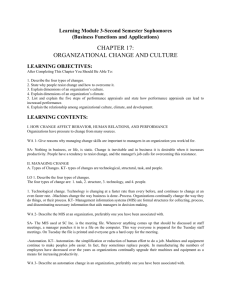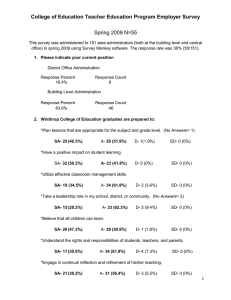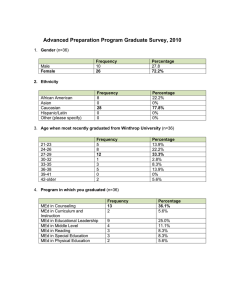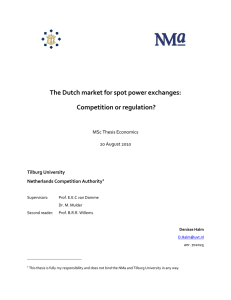How to calculate actual percentage when there are
advertisement
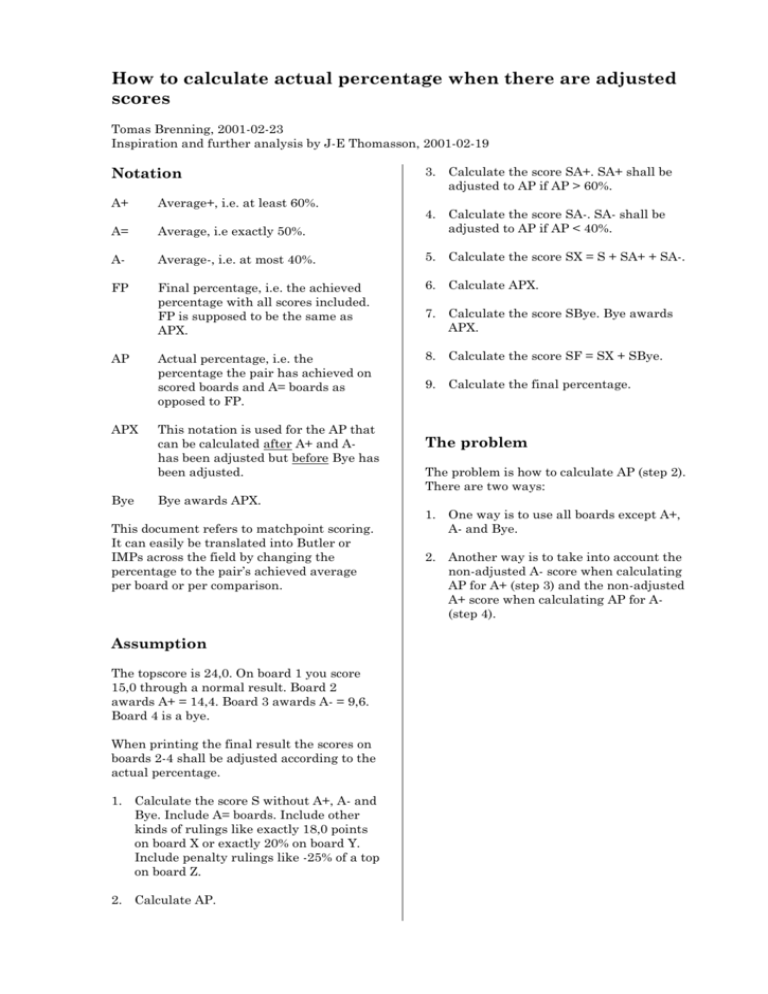
How to calculate actual percentage when there are adjusted scores Tomas Brenning, 2001-02-23 Inspiration and further analysis by J-E Thomasson, 2001-02-19 Notation 3. Calculate the score SA+. SA+ shall be adjusted to AP if AP > 60%. A+ Average+, i.e. at least 60%. A= Average, i.e exactly 50%. 4. Calculate the score SA-. SA- shall be adjusted to AP if AP < 40%. A- Average-, i.e. at most 40%. 5. Calculate the score SX = S + SA+ + SA-. FP Final percentage, i.e. the achieved percentage with all scores included. FP is supposed to be the same as APX. 6. Calculate APX. Actual percentage, i.e. the percentage the pair has achieved on scored boards and A= boards as opposed to FP. 8. Calculate the score SF = SX + SBye. AP APX Bye This notation is used for the AP that can be calculated after A+ and Ahas been adjusted but before Bye has been adjusted. 7. Calculate the score SBye. Bye awards APX. 9. Calculate the final percentage. The problem The problem is how to calculate AP (step 2). There are two ways: Bye awards APX. This document refers to matchpoint scoring. It can easily be translated into Butler or IMPs across the field by changing the percentage to the pair’s achieved average per board or per comparison. Assumption The topscore is 24,0. On board 1 you score 15,0 through a normal result. Board 2 awards A+ = 14,4. Board 3 awards A- = 9,6. Board 4 is a bye. When printing the final result the scores on boards 2-4 shall be adjusted according to the actual percentage. 1. Calculate the score S without A+, A- and Bye. Include A= boards. Include other kinds of rulings like exactly 18,0 points on board X or exactly 20% on board Y. Include penalty rulings like -25% of a top on board Z. 2. Calculate AP. 1. One way is to use all boards except A+, A- and Bye. 2. Another way is to take into account the non-adjusted A- score when calculating AP for A+ (step 3) and the non-adjusted A+ score when calculating AP for A(step 4). Solution 1 This is the mainstream solution that I think most people can live with. It is also the easiest to understand. It is basically described through steps 1-9 above. 1. 2. 3. 4. 5. 6. 7. 8. 9. S = 15,0 AP = 15,0 / 24,0 = 62,5% AP > 60% => SA+ = 62,5 % * 24,0 = 15,0 AP is not < 40% => SA- = 40% = 9,6 SX = S + SA+ + SA- = 39,6 APX = 39,6 / (3 * 24,0) = 55,0% SBye = 55,0 * 24,0 = 13,2 SF = SX + SBye = 52,8 FP = 52,8 / (4 * 24,0) = 55,0% Solution 1 is not used in Magic Contest. Solution 2 This is the solution I recommend even though I think it will be difficult to convince people it is correct. I used the argument ”feeling” to try to prove my theory. 1. S = 15,0 2. AP can not be calculated yet. Two different APs will be used, one for the calculation of SA+ (AP+), one for SA(AP-). 3. To calculate AP+, we need to take into account the non-adjusted SA- = 9,6. S = 15,0 + 9,6 = 24,6. AP = 24,6 / (2 * 24,0) = 51,25%. AP is not > 60% => SA+ = 14,4. The chain of calculations can generally be described as setting up three hypotheses to what AP actually is (with all boards except Bye as the basis) and then trying them, one at a time. The three hypotheses are, of course: 1. AP is less than 40% 2. AP is greater than 60% 3. AP is in the interval 40% to 60% Hypothesis 1 — AP < 40% If the hypothesis is true, the following equation is correct: X = (62,5% + 60,0% + X) / 3 X is the actual percentage we are trying to calculate, 62,5% is the percentage of the score 15,0 and 60% is the score for A+, i.e. 60% since the assumption is that AP < 40%. The equation is solved in detail: 3X = 62,5 + 60,0 + X 2X = 62,5 + 60,0 2X = 122,5 X = 61,25% i.e. the same percentage you can find in step 4 of Solution 2. This is not a correct solution since the assumption states AP < 40%. The only thing we know so far is that AP >= 40% Hypothesis 2 — AP > 60% 4. To calculate AP-, we need to take into account the non-adjusted SA+ = 14,4. S = 15,0 + 14,4 = 29,4. AP = 29,4 / (2 * 24,0) = 61,25%. AP is not < 40% => SA- = 9,6. If the hypothesis is true, the following equation is correct: 5. SX = S + SA+ + SA- = 39,0 The reasoning from hypothesis 1 can be applied. The equation is solved in detail: 6. APX = 39,0 / (3 * 24,0) = 54,1667% 7. SBye = 54,1667 * 24,0 = 13,0 8. SF = SX + SBye = 52,0 9. FP = 52,0 / (4 * 24,0) = 54,1667% Jan-Erik Thomasson, even though he is in favour of solution 1, helped me with the arguments. Everything from here and on is credit to JET. X = (62,5% + X + 40,0%) / 3 3X = 62,5 + X + 40,0 2X = 62,5 + 40,0 2X = 102,5 X = 51,25% i.e. the same percentage you can find in step 3 of Solution 2. This is not a correct solution since the assumption states AP > 60%. The only thing we know so far is that AP >= 40% (hypothesis 1) and AP <= 60% (hypothesis 2). Hypothesis 3 — AP>=40% and AP<=60% If the hypothesis is true, the following equation is correct. This is just a formality since we know from hypothesis 1 and 2 that AP is in the interval 40% to 60%. X = (62,5% + 60,0% + 40,0%) / 3 3X = 62,5 + 60,0 + 40,0 3X = 162,5 X = 54,17% i.e. the same as step 6 and 9 of Solution 2. The example confirms that the hypothesis is true. Apply the solution AP in step 2 can be calculated by applying the three hypotheses one by one. When the correct hypothesis has been found, that hypothesis is used to calculate AP. The following steps (3-9) can be applied in the same way as in solution 1 (or solution 2 for that matter). JET means that the two solutions are the same except for the philosophical difference whether A+ and A- shall contribute to the AP that is the basis of the correction of A+ and A-.





